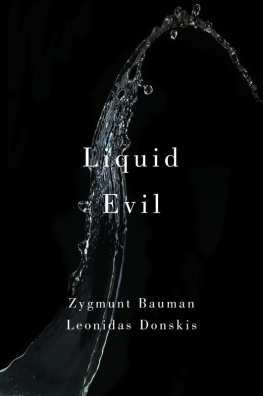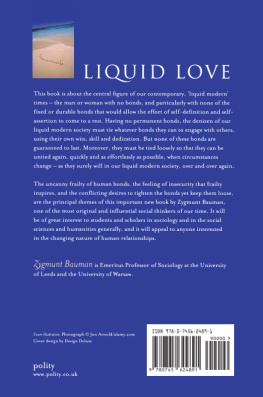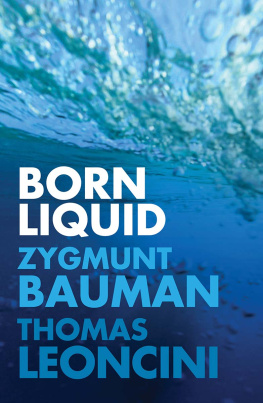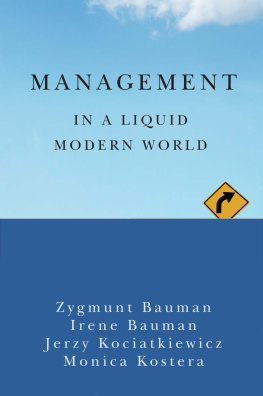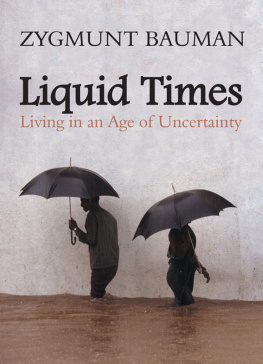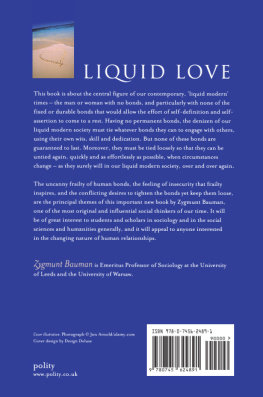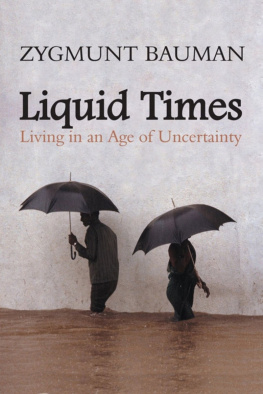
Copyright page
Copyright Zygmunt Bauman & Leonidas Donskis 2016
The right of Zygmunt Bauman and Leonidas Donskis to be identified as Authors of this Work has been asserted in accordance with the UK Copyright, Designs and Patents Act 1988.
First published in 2016 by Polity Press
Polity Press
65 Bridge Street
Cambridge CB2 1UR, UK
Polity Press
350 Main Street
Malden, MA 02148, USA
All rights reserved. Except for the quotation of short passages for the purpose of criticism and review, no part of this publication may be reproduced, stored in a retrieval system or transmitted, in any form or by any means, electronic, mechanical, photocopying, recording or otherwise, without the prior permission of the publisher.
ISBN-13: 978-1-5095-0811-2
ISBN-13: 978-1-5095-0812-9 (pb)
A catalogue record for this book is available from the British Library.
Library of Congress Cataloging-in-Publication Data
Bauman, Zygmunt, 1925
Liquid evil / Zygmunt Bauman, Leonidas Donskis.
pages cm
Includes bibliographical references and index.
ISBN 978-1-5095-0811-2 (hardback) ISBN 978-1-5095-0812-9 (pbk.) 1. Good and evil. I. Title.
BJ1401.B38 2015
170dc23
2015024822
Typeset in 11 on 13 pt Sabon
by Toppan Best-set Premedia Limited
Printed and bound in Great Britain by Clays Ltd, St Ives PLC.
The publisher has used its best endeavours to ensure that the URLs for external websites referred to in this book are correct and active at the time of going to press. However, the publisher has no responsibility for the websites and can make no guarantee that a site will remain live or that the content is or will remain appropriate.
Every effort has been made to trace all copyright holders, but if any have been inadvertently overlooked the publisher will be pleased to include any necessary credits in any subsequent reprint or edition.
For further information on Polity, visit our website:
politybooks.com
About This Book
But a few days after putting the finishing touches to the transcript of our conversation (published two years ago by Polity under the title Moral Blindness), we realized that our conversation needed to continue. Too many strings attached remained untied, and too many new ones, first invisible but by then increasingly salient, demanded to be put on record and tried to be tied. This was not the fault of authors stopping their analytical efforts prematurely, before the task had reached its completion but the consequence of the very nature of the undertaking.
While evil as such the object of our investigation can be seen as a permanent, inalienable companion of the human condition, its forms and ways of operation, particularly in their present-day liquidized incarnation, are novel phenomena; they deserve separate treatment, in which precisely their novelty is cast in the centre of attention. It is in the nature of all liquids that they are incapable of keeping any of their successively adopted shapes and forms for long. Liquids are perpetually in statu nascendi always becoming, rather than having acquired an accomplished form: a quality noted more than two millennia ago by Heraclitus, observing that one can't step twice into the same river, as noted by Plato in his Cratylus dialogue. What one can and needs to do, when aiming at its fullest possible representation, is to discover the river's sources and its most copious tributaries, trace the trajectory of the riverbed (or, if such needs arise, its multiple coexisting or alternating trajectories), and map them both (even if being aware that what can ultimately be achieved is more of the nature of a snapshot than of the conclusive, lasting image of the phenomenon in question).
This is exactly what we try to do in this book: to chart as fully as possible the currently most prolific sources of evil, and follow as many as possible of its trajectories at the present stage of our liquid-modern, deregulated and disorganized, atomized and individualized, fragmented, disjointed and privatized society of consumers. All the same, given the attributes of the object, the result needs to be viewed as a career-report of an on-going voyage of discovery.
Our conversation, in a nutshell, has been about the specifically liquid-modern mode of evil a mode arguably yet more menacing and treacherous than evil's other historical manifestations because of being fractured, pulverized, disjointed and disseminated; starkly distinct from its immediately preceding variety, concentrated and condensed as it struggled to be, as well as centrally administered. For that reason, the present-day liquidized evil is hidden from sight and avoids being spotted, as well as recognition for what it is and what it portends. Liquid evil has the awesome capacity for effective disguises and for recruiting human all-too-human concerns and desires to its service under false yet exceedingly difficult to debunk and falsify pretences. To add offence to the injury, quite a few recruits are seduced into volunteering.
In an enormous number of cases, liquidized evil manages to be perceived as a friend eager to help rather than a fiend; in Joseph Nye's terminology, it needs to be counted among the soft as distinct from hard powers, deploying temptation instead of coercion as its basic strategy, as in the case of contemporary multifaceted surveillance building a data bank millions of times more capacious than all the secret services of the solid-modern past could only dream of (and even then on condition of possessing extraordinary imagination) from information supplied 24 hours a day and 7 days a week, voluntarily or unknowingly, by the users of cellular telephones, of credit cards, and by senders or receivers of computerized messages. No longer is the Ministry of Love needed to force people to take war for peace and coercion for care and friendly assistance.
Liquid evil, like all liquids, has the awesome capability of flowing around the obstacles rising or standing on its way. Like other liquids, it drenches them on its way, moistens, soaks and all too often erodes and dissolves absorbing the solution in its own substance to further enhance its body. In addition to evasiveness, this capacity renders effective resistance to liquid evil yet more formidable a task. Having impregnated in the tissue of daily life and entrenched in its very core, evil, when (if) spotted, makes all alternative modes of life look implausible, indeed unreal; lethal poison presents itself duplicitously as a life-saving antidote to life's hardships.
Of these and other adjunct traits of liquid evil, in their many manifestations, we attempt to make a (by necessity incomplete, but hopefully preliminary) inventory. Our intention is to prime the canvas, rather than paint a complete picture. We hope to sketch the area yearning for research as comprehensive as it is urgent and equip it with some in our belief useful conceptual tools.
Z.B. & L.D.
Introduction: On Liquid Evil and TINA
Leonidas Donskis We live in a world without alternatives. It's a world that proposes a single reality and a world that labels as lunatics or, at best, eccentrics all those who believe that everything has an alternative, including even the very best models of governance and the most profound ideas (not to mention business and engineering projects). The world has probably never been so inundated with fatalistic and deterministic beliefs as it is today; alongside serious analyses, as if from a horn of plenty, flow prophecies and projections of looming crises, dangers, downward spirals, and the end of the world. In this widespread atmosphere of fear and fatalism, the conviction arises that there are no alternatives to contemporary political logic and to the tyranny of the economy or to attitudes towards science and technology and the relationship between nature and humanity. Not by any stretch is optimism the foolish exultation that we are here in this place and that our surroundings are warm, fuzzy and comfortable; rather, it is the belief that evil is transitory and does not vanquish humaneness (or only briefly when it does). Furthermore, optimism means a belief that hope and alternatives do indeed always exist. The conviction that a pessimist is an all-round loftier and nobler being than an optimist is not simply a relic of the modern, Romantic sensibility and worldview it is something greater.
Next page
